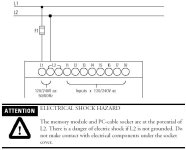best49erfan
Member
I was reading the getting results manual and it talks about having the memory module. Do you have to have that to retain the program in the Pico or will it lose the program after every powerdown?
well i couldnt find a cord to use to power it up. I found one a little bit ago.....a spare PC power cord.....
rsdoran said:Does it matter? Green is ground and should be specific, unless the neutral is bonded at the plc (which is unlikely) then L1 and L2 probably wont matter how is connected.
Does it matter?

Eric Nelson said:Your thoughts?
rsdoran said:In many cases when using a "control" transformer neither terminal is bonded to ground....
rsdoran said:this means that when measuring either TAP to ground you will see 1/2 of the supplied voltage, thats the main reason for connecting one leg to ground...it supplies a reference that is relevant to ground potential.

